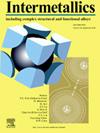Interfacial microstructure evolution and mechanical characterization of brazed Al2O3 joints with Ni‒Ti interlayer: An experimental and theoretical approach
IF 4.3
2区 材料科学
Q2 CHEMISTRY, PHYSICAL
引用次数: 0
Abstract
Reliable brazing joints of Al2O3 ceramics were obtained using an active Ni‒Ti interlayer under vacuum conditions. The interfacial microstructure and mechanical properties of the joints were studied. The structural, electronic, and elastic properties of the primary interfacial reaction phases were determined using first–principles calculations. After brazing at 1320 °C for 30 min, Ni2Ti4O layer and columnar AlNi2Ti formed at the interface adjacent to the Al2O3 substrate. With increasing brazing temperature between 1300 °C and 1380 °C, Ni2Ti4O layer thickened gradually, and the AlNi2Ti became increasingly longer. As brazing temperature reached 1400 °C, TiO was formed at the interface, and the Ni2Ti4O content decreased significantly; moreover, bulk AlNi2Ti and TiNi3 were distributed in the brazing seam. The highest shear strength of 129 MPa was achieved when brazed at 1350 °C for 30 min. According to the first–principles calculations, Ni2Ti4O is more readily formed than AlNi2Ti, whereas AlNi2Ti exhibits greater stability than Ni2Ti4O. Both AlNi2Ti and Ni2Ti4O possess metallic bonds, contributing to the adhesion of the filler metal to the Al2O3 substrates. The calculated modulus and Poisson’s ratio indicate that both AlNi2Ti and Ni2Ti4O exhibit ductile characteristics, which assist in relieving residual stress within the joint.
带有镍钛夹层的钎焊 Al2O3 接头的界面微观结构演变和力学特性:实验和理论方法
在真空条件下,使用活性镍钛中间膜获得了可靠的 Al2O3 陶瓷钎焊接头。对接头的界面微观结构和机械性能进行了研究。通过第一原理计算确定了主要界面反应相的结构、电子和弹性特性。在 1320 °C 下钎焊 30 分钟后,与 Al2O3 基底相邻的界面上形成了 Ni2Ti4O 层和柱状 AlNi2Ti。随着钎焊温度在 1300 ℃ 至 1380 ℃ 之间的升高,Ni2Ti4O 层逐渐变厚,AlNi2Ti 越来越长。当钎焊温度达到 1400 ℃ 时,界面上形成了 TiO,Ni2Ti4O 含量显著下降;此外,钎缝中分布着块状 AlNi2Ti 和 TiNi3。在 1350 °C 下钎焊 30 分钟时,达到了 129 兆帕的最高剪切强度。根据第一原理计算,Ni2Ti4O 比 AlNi2Ti 更容易形成,而 AlNi2Ti 比 Ni2Ti4O 表现出更高的稳定性。AlNi2Ti 和 Ni2Ti4O 都具有金属键,有助于填充金属与 Al2O3 基底的粘合。计算得出的模量和泊松比表明,AlNi2Ti 和 Ni2Ti4O 都具有延展性,有助于消除连接处的残余应力。
本文章由计算机程序翻译,如有差异,请以英文原文为准。
求助全文
约1分钟内获得全文
求助全文
来源期刊

Intermetallics
工程技术-材料科学:综合
CiteScore
7.80
自引率
9.10%
发文量
291
审稿时长
37 days
期刊介绍:
This journal is a platform for publishing innovative research and overviews for advancing our understanding of the structure, property, and functionality of complex metallic alloys, including intermetallics, metallic glasses, and high entropy alloys.
The journal reports the science and engineering of metallic materials in the following aspects:
Theories and experiments which address the relationship between property and structure in all length scales.
Physical modeling and numerical simulations which provide a comprehensive understanding of experimental observations.
Stimulated methodologies to characterize the structure and chemistry of materials that correlate the properties.
Technological applications resulting from the understanding of property-structure relationship in materials.
Novel and cutting-edge results warranting rapid communication.
The journal also publishes special issues on selected topics and overviews by invitation only.
 求助内容:
求助内容: 应助结果提醒方式:
应助结果提醒方式:


